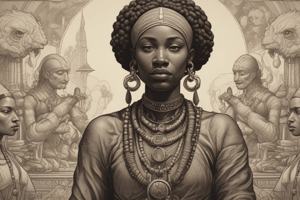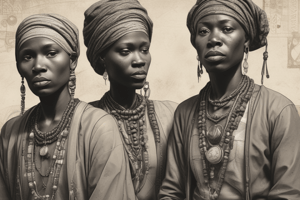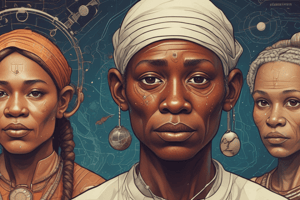Podcast
Questions and Answers
What term was used to refer to an epicanthic fold of the eyelid before it was criticized?
What term was used to refer to an epicanthic fold of the eyelid before it was criticized?
- Ethiopian fold
- Caucasoid fold
- Mongoloid fold (correct)
- Negroid fold
Which researcher first described the condition now known as Down syndrome?
Which researcher first described the condition now known as Down syndrome?
- Charles Darwin
- Carl Linnaeus
- John Langdon Down (correct)
- Francis Galton
From which Latin word is 'Negroid' derived?
From which Latin word is 'Negroid' derived?
- Rufus
- Candidus
- Niger (correct)
- Albus
What is a characteristic consequence of increased melanin in the skin?
What is a characteristic consequence of increased melanin in the skin?
Which term did Blumenbach use for what is now referred to as 'Negroid'?
Which term did Blumenbach use for what is now referred to as 'Negroid'?
What view do some Japanese scholars hold regarding the term 'Mongoloid'?
What view do some Japanese scholars hold regarding the term 'Mongoloid'?
Which of the following statements characterizes the term 'Caucasoid' as used by Blumenbach?
Which of the following statements characterizes the term 'Caucasoid' as used by Blumenbach?
Which population group is noted to have a close genetic relationship to East Asians rather than Africans?
Which population group is noted to have a close genetic relationship to East Asians rather than Africans?
What is the historical origin of the term 'Caucasoid'?
What is the historical origin of the term 'Caucasoid'?
What connotation is associated with the term 'Mongoloid'?
What connotation is associated with the term 'Mongoloid'?
Who is recognized as the founding father of craniometry, which laid the groundwork for racial classifications such as 'Caucasoid' and 'Mongoloid'?
Who is recognized as the founding father of craniometry, which laid the groundwork for racial classifications such as 'Caucasoid' and 'Mongoloid'?
What was the significance of the Caucasus Mountains in Blumenbach's research?
What was the significance of the Caucasus Mountains in Blumenbach's research?
What impact did the comments of Brace (1995) have on the use of the term 'Mongoloid'?
What impact did the comments of Brace (1995) have on the use of the term 'Mongoloid'?
Why did Blumenbach name Europeans 'Caucasians'?
Why did Blumenbach name Europeans 'Caucasians'?
What does the author believe is crucial for contemporary society regarding the terms 'Caucasoid' and 'Mongoloid'?
What does the author believe is crucial for contemporary society regarding the terms 'Caucasoid' and 'Mongoloid'?
In what context were 'Caucasoid' and 'Mongoloid' widely employed despite their problematic nature?
In what context were 'Caucasoid' and 'Mongoloid' widely employed despite their problematic nature?
How did Blumenbach perceive the relationship between the Caucasian, Mongolian, and Ethiopian classifications?
How did Blumenbach perceive the relationship between the Caucasian, Mongolian, and Ethiopian classifications?
What approach does the author take toward historical prejudices associated with racial terms?
What approach does the author take toward historical prejudices associated with racial terms?
What aesthetic characteristic did Blumenbach attribute to the Caucasian skull?
What aesthetic characteristic did Blumenbach attribute to the Caucasian skull?
What was Blumenbach's stance on the unity of the human species?
What was Blumenbach's stance on the unity of the human species?
What did the physical anthropologist at the 1989 conference propose in response to the term 'Mongoloid'?
What did the physical anthropologist at the 1989 conference propose in response to the term 'Mongoloid'?
How did Blumenbach's perspective reflect the societal attitudes of his time?
How did Blumenbach's perspective reflect the societal attitudes of his time?
In Blumenbach's view, which group was positioned between Caucasians and Mongolians?
In Blumenbach's view, which group was positioned between Caucasians and Mongolians?
What justification did Blumenbach offer for his classifications?
What justification did Blumenbach offer for his classifications?
What change did Mark Keevak note regarding Linnaeus' classification of Asians?
What change did Mark Keevak note regarding Linnaeus' classification of Asians?
What negative connotation does the term 'luridus' carry in relation to skin color?
What negative connotation does the term 'luridus' carry in relation to skin color?
Which of the following classifications did Buffon use in his six varieties of humans?
Which of the following classifications did Buffon use in his six varieties of humans?
According to Buffon, where did he believe the 'Garden of Eden' was located?
According to Buffon, where did he believe the 'Garden of Eden' was located?
What concept did Buffon propose regarding the degeneration of human varieties?
What concept did Buffon propose regarding the degeneration of human varieties?
Which individual first coined the terms 'Caucasoid' and 'Mongoloid' in racial classification?
Which individual first coined the terms 'Caucasoid' and 'Mongoloid' in racial classification?
Blumenbach's classification of humans was based on what method?
Blumenbach's classification of humans was based on what method?
How did Buffon view the migration of humans from their original location?
How did Buffon view the migration of humans from their original location?
What problem is highlighted regarding the usage of racial terms by the Japanese?
What problem is highlighted regarding the usage of racial terms by the Japanese?
What has been a major consequence of the 19th-century racial classification?
What has been a major consequence of the 19th-century racial classification?
Which disciplines are called to engage in dialogue regarding racial terminology issues?
Which disciplines are called to engage in dialogue regarding racial terminology issues?
What is suggested as necessary for addressing the issues surrounding population descriptors?
What is suggested as necessary for addressing the issues surrounding population descriptors?
Who held discussions about categorizations and population descriptors?
Who held discussions about categorizations and population descriptors?
What does the continuing usage of certain racial terms by the Japanese reveal?
What does the continuing usage of certain racial terms by the Japanese reveal?
What type of project is mentioned regarding the global study of racial representations?
What type of project is mentioned regarding the global study of racial representations?
Which of these individuals is noted for discussing racial classifications?
Which of these individuals is noted for discussing racial classifications?
Which author focused on the historical perspective of race in America?
Which author focused on the historical perspective of race in America?
What is the main focus of Kenan Malik's work?
What is the main focus of Kenan Malik's work?
Which work publishes narratives of travels including those from John Mandeville?
Which work publishes narratives of travels including those from John Mandeville?
Which author is associated with the concept of divisions into human races dating back to Linnaeus?
Which author is associated with the concept of divisions into human races dating back to Linnaeus?
What is the publication year of 'The Races of Europe' by William Zebina Ripley?
What is the publication year of 'The Races of Europe' by William Zebina Ripley?
Who edited the work that includes Buffon's writings on varieties within the human species?
Who edited the work that includes Buffon's writings on varieties within the human species?
Which publication emphasizes Asians in American history and culture?
Which publication emphasizes Asians in American history and culture?
Who wrote 'Becoming Yellow: A Short History of Racial Thinking'?
Who wrote 'Becoming Yellow: A Short History of Racial Thinking'?
Flashcards
Craniometry
Craniometry
The use of skull measurements (crania) to classify people into racial categories. This practice was central to the development of racial classification in modern science.
Johann Friedrich Blumenbach
Johann Friedrich Blumenbach
The father of craniometry, a German scientist who developed the racial classification system that laid the foundation for terms like 'Caucasoid' and 'Mongoloid'.
Caucasoid
Caucasoid
A term used in the 18th and 19th centuries to classify people of European descent as a racial category. Its origin can be traced back to the biblical story of Noah's ark.
Mongoloid
Mongoloid
Signup and view all the flashcards
Physical Anthropology
Physical Anthropology
Signup and view all the flashcards
Dissemination of discriminatory terms
Dissemination of discriminatory terms
Signup and view all the flashcards
Building currency of a term
Building currency of a term
Signup and view all the flashcards
Racial classification
Racial classification
Signup and view all the flashcards
Linnaeus's Terminology Shift
Linnaeus's Terminology Shift
Signup and view all the flashcards
Buffon's Classification of Humans
Buffon's Classification of Humans
Signup and view all the flashcards
Buffon's Theory of Degeneration
Buffon's Theory of Degeneration
Signup and view all the flashcards
Blumenbach's Classification System
Blumenbach's Classification System
Signup and view all the flashcards
Blumenbach's Shift in Approach
Blumenbach's Shift in Approach
Signup and view all the flashcards
Eurocentrism
Eurocentrism
Signup and view all the flashcards
Disseminating discriminatory terms
Disseminating discriminatory terms
Signup and view all the flashcards
Problem with Racial Terms
Problem with Racial Terms
Signup and view all the flashcards
Currency of a Term
Currency of a Term
Signup and view all the flashcards
Collaboration in Terminology
Collaboration in Terminology
Signup and view all the flashcards
Buffon's Degeneration Theory
Buffon's Degeneration Theory
Signup and view all the flashcards
Buffon's Human Classification
Buffon's Human Classification
Signup and view all the flashcards
Mongoloid Fold
Mongoloid Fold
Signup and view all the flashcards
Down syndrome
Down syndrome
Signup and view all the flashcards
Negroid
Negroid
Signup and view all the flashcards
Melanin
Melanin
Signup and view all the flashcards
"Mongoloid", "Caucasoid", and "Negroid"
"Mongoloid", "Caucasoid", and "Negroid"
Signup and view all the flashcards
Use of "Mongoloid" in Japan
Use of "Mongoloid" in Japan
Signup and view all the flashcards
Study Notes
Introduction
- "Mongoloid" and "Caucasoid" terms are prevalent in Japanese school materials and encyclopedias
- "Mongoloid" is frequently used by experts and in TV documentaries
- "Caucasoid" originates from the Old Testament
- "Mongoloid" has discriminatory connotations.
- This paper examines historical development and racial classification, focusing on modern scientific viewpoints.
- The study avoids criticizing past prejudices but aims to understand the problematic terms' connotations.
Race Classification in Modern Science
- Johann Friedrich Blumenbach's work laid the foundation for "Caucasoid" and "Mongoloid" terms.
- François Bernier pioneered modern racial classification.
- Carolus Linnaeus classified humans into four categories based on physical features.
- Linnaeus' classification was influenced by the four humors theory.
- The classification reflected the European worldview.
- Blumenbach's racial classification used skull measurements influencing the concept of race.
- Blumenbach identified five types of humans: Caucasian, Mongolian, Ethiopian, American, and Malayan.
- Blumenbach differentiated these classifications though colour, initially by "white", "yellow", "black", "red" and "brown"
Eurocentrism and Racial Terminology
-
"Caucasoid" is associated with a Judeo-Christian worldview, particularly with Mount Ararat.
-
Blumenbach's "Caucasian" was based on a skull from the Caucasus.
-
Blumenbach considered Caucasian humans the original archetype.
-
"Mongoloid" is linked to the Mongol Empire's military power, mirroring European views.
-
Marco Polo and other accounts influenced European perceptions of Asia.
-
The term "Mongoloid" was also used to describe a chromosomal condition (Down syndrome).
-
"Negroid" derives from the Latin word "niger" (black).
-
Skin colour is a feature used but skin colour alone cannot adequately categorize different ethnic groups.
Toward Cross-Disciplinary Dialogue
- "Caucasoid," "Mongoloid," and "Negroid" reflect Eurocentric views.
- Modern scientific understanding has moved beyond strict racial categorization.
- The study highlights the need for cross-disciplinary dialogue and alternative terminologies.
Studying That Suits You
Use AI to generate personalized quizzes and flashcards to suit your learning preferences.
Related Documents
Description
Test your knowledge on historical terms and classifications related to race and ethnicity. This quiz covers the origins, definitions, and implications of terms such as 'Caucasoid', 'Mongoloid', and 'Negroid', as well as key researchers in the field. Explore the historical context and significance of these terms in anthropology and social sciences.




